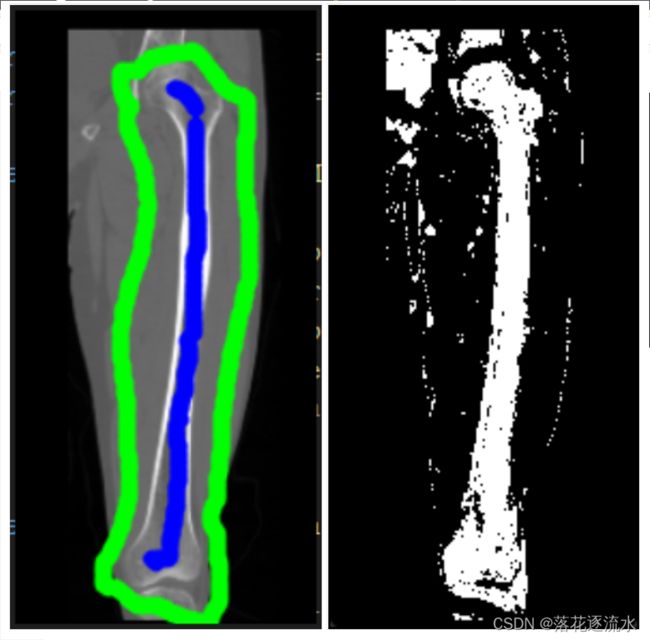经典图割算法中图的构建及实现:Graph-Cut
经典图割算法中图的:Graph-Cut
- 一.graph-cut:准则函数
- 二.Graph-cut:图的建立
-
- 1.术语:
- 2.图的建立
- 3. 头文件
- 4. 源文件
- 5. 测试图像
讲解目前典型的3种图割算法:graph-cut、grab-but、one-cut。本文主要讲解graph-cut的方法在应用时,准则函数与图构建关系,如何构建图,以及如何代码实现图的构建。图割的原理网上文章和论文已介绍比较详细,不再详细介绍。
一.graph-cut:准则函数
该方法可谓是图割方法的开山鼻祖。该方法的准则函数如下:
E ( A ) = λ R ( A ) + B ( A ) E(A) = \lambda R(A) + B(A) E(A)=λR(A)+B(A)
R(A)是先验惩罚项,B(A)是区域相似度惩罚项, λ \lambda λ是平衡因子。
该准则函数意义:同类间,颜色差别小;异类间,颜色差别大。原则上该准则可解决图像任意类分割,并且一定是有全局最优解得,但在无种子点的超过2分类的问题时,该优化是个NP难问题,需要进行指数级的比较才能获得最优解,无工程价值。
二.Graph-cut:图的建立
1.术语:
- 与S和T链接的边叫t-link(红线与绿线),领域之间的链接边叫n-link(黑线)。其中红线进一步称为s-t-link,绿线进一步称为t-t-link。
- 黑线的权值对应的是B(A)项,红线与绿线的权值对应的是R(A)项。
- 权值用w表示。
- 蓝色节点表示类别标志节点,S表示正类类标节点,T表示负类类标节点,黄色节点是图像中的每一个像素点。
最终通过求最小割之后,与节点S相连的所有黄色节点(图像像素点)属于一类,同理与节点T相连的所有黄色节点属于另一类。两类被最小割割开,割值即是准则函数的值。
2.图的建立
拿到待分割的图像后,图的节点与边已确定,即图的形状已确定下来。仅仅需要做的就是给图中所有边赋值相应的权值。
图中的边有3种情况:种子点的t-link;非种子点的t-link;像素领域关系的n-link。接下来将说明每一种边的权值取值。
1).种子点t-link权值:种子点认为是硬约束,其用户预设类别后,类别不会随分割算法而改变。
a.对于正类别种子点,s-t-link必须保留,t-t-link必须割去。工程中,通过将s-t-link权值设置为超级大值,t-t-link设置为0。保证一定仅仅割去t-t-link,否则一定不是最小割,因为当前w(s-t-link)权值是超级大值,割去这条边的代价一定是最大的。
b.反之同理。
2).非种子点的t-link权值:通过正负类种子点,我们能建立2类的颜色直方图。将直方图归一化成概率密度函数,定义为H_F,H_B。其中s-t-link权值为-ln(H_F(x)),t-t-link权值为-ln(H_B(x)),x为该像素点颜色值。
3).n-link权值:n-link用于度量相邻像素点之间颜色的差异性。设一对相邻点Pi,Pj,则n-link(Pi-Pj)的权值w等于:
w = exp ( − ( x i − x j ) 2 2 σ 2 ) ⋅ 1 d i s t ( P i , P j ) w = \exp(-\frac{(x_i - x_j)^2}{2\sigma^2}) \cdot \frac{1}{dist(P_i,P_j)} w=exp(−2σ2(xi−xj)2)⋅dist(Pi,Pj)1
其中,dist()是距离函数,表示点之间的图像距离。即4领域下,所以领域点距离均为1,;8领域下,对角像素点距离为 2 \sqrt{2} 2;在5*5领域下,对角像素点距离为 2 2 2\sqrt{2} 22。
设种子点的超级大值是1000, σ = 1 \sigma = 1 σ=1。图像是3*2的灰度图,数字表示灰度值,红色和蓝色节点表示用户选择的正负种子点。当然种子点过少时,计算的H_F,H_B可能不准,可将种子点附近的像素点也算入先验直方图中,往往可以取得更好效果。

如上图所示,将所有边的权值赋值后,图就建立完毕。剩余则直接运用最小割算法即可求解。最小割算法有很多,包括graph-cut作者提出的快速算法An Experimental Comparison of Min-Cut/Max-Flow Algorithms for Energy Minimization in Vision。Opencv即采用该算法计算最小割。
代码适配了opencv4.6.0
3. 头文件
gcgraphMy.h
#include 4. 源文件
main.cpp
#include 5. 测试图像
上述代码核心部分不是调用opencv实现的。
代码有冗余,是没有完成的Grabcut部分。可运行部分是GraphCut部分。

参考:经典图割算法中图的构建及实现:Graph-Cut

